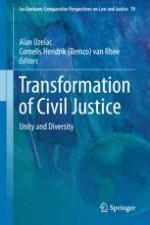2018 | OriginalPaper | Buchkapitel
The Disappearing Trial: Retrenchment of Litigation in North America
verfasst von : Margaret Woo
Erschienen in: Transformation of Civil Justice
Aktivieren Sie unsere intelligente Suche, um passende Fachinhalte oder Patente zu finden.
Wählen Sie Textabschnitte aus um mit Künstlicher Intelligenz passenden Patente zu finden. powered by
Markieren Sie Textabschnitte, um KI-gestützt weitere passende Inhalte zu finden. powered by
